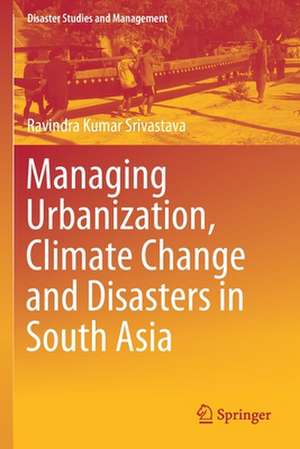Managing Urbanization, Climate Change and Disasters in South Asia: Disaster Studies and Management
Autor Ravindra Kumar Srivastavaen Limba Engleză Paperback – 22 iul 2021
The book draws the attention of urban planners and policymakers to current shortcomings in the administrative and financial structures of local urban bodies. While outlining climate-associated risks and adaptation strategies in South Asia, it also suggests measures for integrating climate change and urban adaption with state's planning processes, and puts forward a risk alleviation platform to bring the risk managers working in different fields together, so that they make concerted efforts to achieve sustainable development. It offers valuable takeaways for researchers, urban planners, those working in industry, consultants, and policymakers.
| Toate formatele și edițiile | Preț | Express |
|---|---|---|
| Paperback (1) | 707.13 lei 6-8 săpt. | |
| Springer Nature Singapore – 22 iul 2021 | 707.13 lei 6-8 săpt. | |
| Hardback (1) | 713.69 lei 6-8 săpt. | |
| Springer Nature Singapore – 21 iul 2020 | 713.69 lei 6-8 săpt. |
Preț: 707.13 lei
Preț vechi: 831.92 lei
-15% Nou
Puncte Express: 1061
Preț estimativ în valută:
135.32€ • 138.59$ • 112.57£
135.32€ • 138.59$ • 112.57£
Carte tipărită la comandă
Livrare economică 18 martie-01 aprilie
Preluare comenzi: 021 569.72.76
Specificații
ISBN-13: 9789811524127
ISBN-10: 9811524122
Ilustrații: XXXVII, 469 p. 135 illus., 132 illus. in color.
Dimensiuni: 155 x 235 mm
Greutate: 0.7 kg
Ediția:1st ed. 2020
Editura: Springer Nature Singapore
Colecția Springer
Seria Disaster Studies and Management
Locul publicării:Singapore, Singapore
ISBN-10: 9811524122
Ilustrații: XXXVII, 469 p. 135 illus., 132 illus. in color.
Dimensiuni: 155 x 235 mm
Greutate: 0.7 kg
Ediția:1st ed. 2020
Editura: Springer Nature Singapore
Colecția Springer
Seria Disaster Studies and Management
Locul publicării:Singapore, Singapore
Cuprins
Chapter-01: Introduction.- Chapter -02: South Asia Region & its Urban Agglomerates -Changing Risk Characterization.- Chapter -03: Disaster Management Scenario of South Asia.- Chapter -04: Manifestations and Impacts of Climate Change in SAR.- Chapter -05 : Urban Setups in South Asia Region (SAR) under Climate Change induced Risk.- Chapter -06 : Challenges of Urbanisation led neo risks and vulnerabilities.- Chapter -07: Institutional Structure for DRR, CCA and Urban Governance.- Chapter -08: Conclusions and Future Perspective – A Road Map.
Notă biografică
Dr. R. K. Srivastava is a former Indian Administrative Service (IAS) officer with extensive field experience in complex areas of governance such as general administration, management, finance, regulatory and judicial. While serving the Government of India (GoI), he had a long stint in the area of disaster management, environmental and forest management. Dr. Srivastava, while serving the DM sector at the federal level, chaired the South Asia Disaster Management Centre in Delhi. He also held the position of Director, National Institute of Disaster Management, Delhi. While serving in the state of Jharkhand as secretary to the state government, he planned and executed major infrastructure and urban development projects. As leader of a disaster management team, he authored the book “Disaster Management of India”, published by UNDP. He has numerous publications on the subjects of flood management, smart cities, urban setups under climate-change-induced risks and several others in national and international journals to his credit. Dr. Srivastava was actively engaged with Jamia Millia Islamia, a central university in Delhi, and contributed his expertise to structure the courses on disaster management and climate sustainability.
Textul de pe ultima copertă
This book offers essential insights into potential catastrophic events that might befall upon the emerging urban landscape in South Asia, and which are due to hazards, risks and vulnerabilities inherent in the region’s geophysical location, as well as due to climate change and unplanned urbanization. It highlights major physio-graphic, demographic, geological and geophysical indicators that are responsible for changing the pattern and trend of urbanization in South Asia – a crucial issue in view of emerging threats of climate change, and changes in the demographic profile. The book addresses the disaster management scenario in South Asia, manifestations of climate change in the region and various urban setups under climate-change-induced risks. Further, it elaborates on the challenges of urbanization-based neo-risks and vulnerabilities, which manifest in the form of slum area growth, piling and littering of waste and filth, new health risks, groundwater contamination, air pollution,highly energy-dependent lifestyles, poverty, socio-economic tensions, etc. It also critically examines the institutional mechanisms for disaster risk reduction (DRR), climate change adaptation (CCA) and urban governance, and suggests appropriate changes in the governing structure to mitigate these risks.
The book draws the attention of urban planners and policymakers to current shortcomings in the administrative and financial structures of local urban bodies. While outlining climate-associated risks and adaptation strategies in South Asia, it also suggests measures for integrating climate change and urban adaption with state's planning processes, and puts forward a risk alleviation platform to bring the risk managers working in different fields together, so that they make concerted efforts to achieve sustainable development. It offers valuable takeaways for researchers, urban planners, those working in industry, consultants, and policymakers.
The book draws the attention of urban planners and policymakers to current shortcomings in the administrative and financial structures of local urban bodies. While outlining climate-associated risks and adaptation strategies in South Asia, it also suggests measures for integrating climate change and urban adaption with state's planning processes, and puts forward a risk alleviation platform to bring the risk managers working in different fields together, so that they make concerted efforts to achieve sustainable development. It offers valuable takeaways for researchers, urban planners, those working in industry, consultants, and policymakers.
Caracteristici
Offers important insights for various stakeholders to help them address different aspects of the disaster response cycle Provides an in-depth discussion on the sources of hazards, risks and vulnerabilities in the context of the urban landscape Analyses shortcomings in institutional structures for risk management established in different fields Illustrates ways of integrating the currently disjoint mechanisms to make various institutions more responsive and effective



